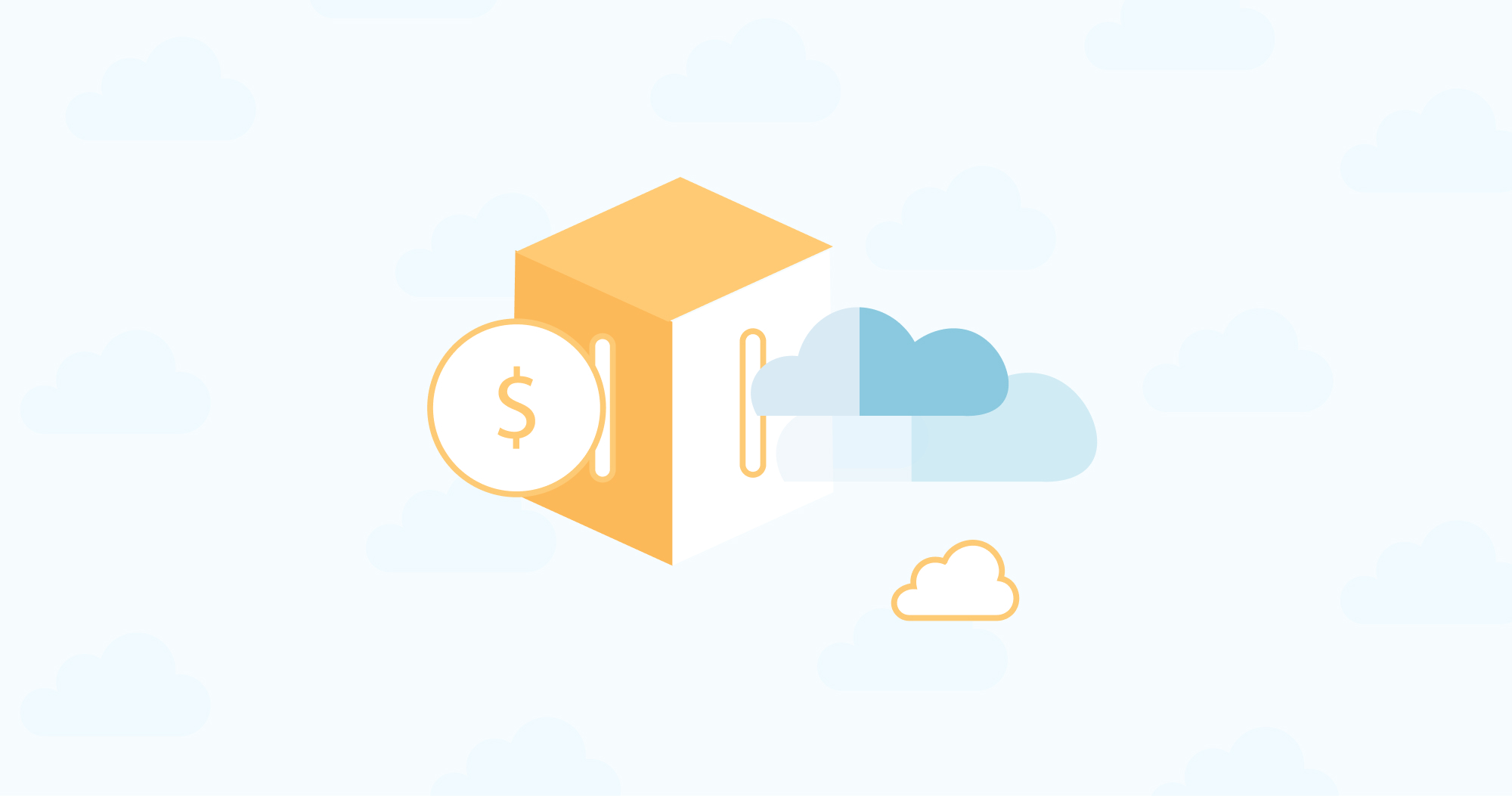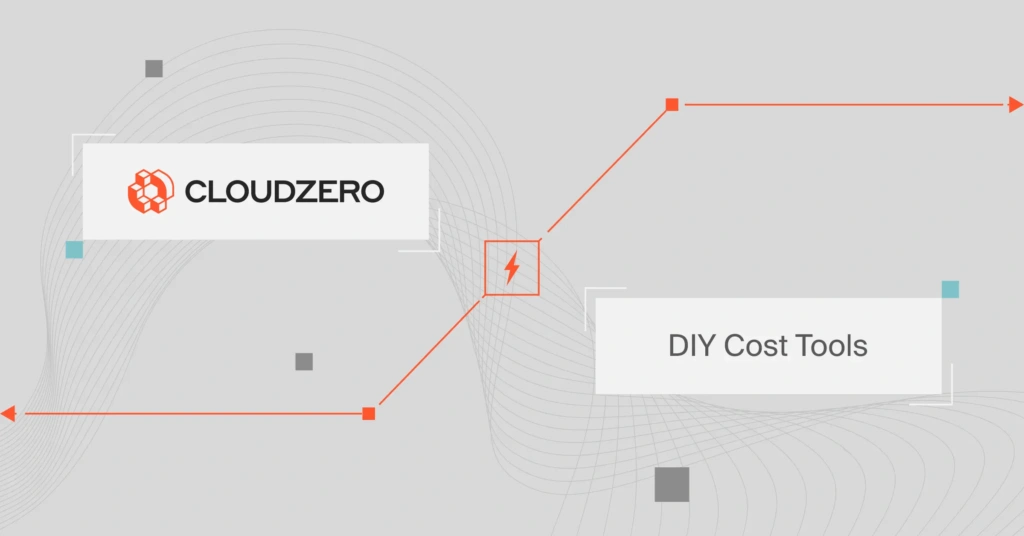From 2022 to 2023, worldwide cloud spending is expected to increase to $597.3 billion, up from $491 billion in 2022. Year over year, that’s a 21.64% increase.
Compare that to the 15.42% increase (at the time of writing) in the Nasdaq-100 Technology Sector Index, and you see a simple, inconvenient truth: Cloud spend is outpacing business growth by a substantial margin.
It’s no wonder that cloud efficiency sits at the top of many companies’ priority lists. And it’s no wonder that, in pursuit of this goal, many companies try homegrown tooling: building their own cost management platform instead of buying a third-party platform.
Using homegrown tooling is a choice made in the name of frugality. It’s an understandable decision, but one that’s fraught with limitations that, for companies with substantial enough cloud footprints, actually make it more expensive than buying a third-party platform.
Previously, CloudZero wrote about the questions to ask yourself when considering whether to build or buy a cloud cost management platform. Here, we compare the benefits and drawbacks of CloudZero versus homegrown tooling in the context of our core differentiators, which align to the FinOps Capabilities.
But First: The Hidden Costs Of Homegrown Cloud Cost Tooling
Companies build their own cost tools to save money. But the limitations of homegrown tooling actually result in a lot of wasted resources, which can be split into three categories:
1. Time (i.e., Money)
It takes a lot of time and effort to build and maintain a homegrown cost tool (we should know). How much time? One CloudZero customer, Hiya, had been using a homegrown cost tool, and spending a week each month maintaining it. And that doesn’t factor in any of the time and effort it took to build it.
In other words, at peak function, the cost tool was taking up 25% of his time. It’s simple math to calculate 25% of your engineering leaders’ salaries and estimate how much money you’ll actually spend building and maintaining a homegrown tool.
By contrast, CloudZero takes no time to build or maintain — that’s our job. Combine the time savings with the money savings revealed by CloudZero, and you start to see quickly how much you can save.
2. Visibility
As we discuss in more detail below, homegrown tools use tagging as their primary method of cost allocation. Tagging has some well-known limitations: In a 2022 study, we found that companies who use tagging as their main method of cost allocation average 75% visibility — and it’s a hard-fought 75%, as it takes a lot of effort to keep it at that level.
CloudZero uses CostFormation®, a language we developed, to allocate 100% of your spend — even untagged, mis-tagged, untaggable, shared, and multi-tenant costs. Better yet, it’s a passive 100% on your part; after some upfront work, allocation is fully automated, letting you focus your energy on efficient innovation.
3. Money
Another consequence of having sub-100% allocation is that you won’t see savings insights from 100% of your spend. Moreover, whatever insights your tool does surface won’t have the same level of drill-down and engagement capabilities that CloudZero does — automated anomaly alerts, custom dashboards, scheduled reporting, and more.
What that means is that homegrown tools will neither surface nor help you realize the level of savings that CloudZero will, leading to overspending, surprise bills, and friction between teams.
1. Cost Allocation
What is it?
Cost allocation is the process by which you assign every penny of your cloud spend to its correct source.
This does mean understanding which specific cloud resources triggered which costs, but it also means two further steps: 1) Associating those resources with the correct customers, teams, products, microservices, and more; and 2) Understanding which of your engineers is responsible for managing those resource costs.
Why does it matter?
Cost allocation is an essential first step in cloud cost management. As with any investment center, cloud cost management starts with assessing what you’re spending and why — then making informed decisions about how to optimize.
You can’t make informed optimization decisions if you don’t have a complete understanding of what you’re spending and why.
How does it save me money?
Before becoming a CloudZero customer, Hiya was using homegrown tooling to manage their cloud costs. After achieving 100% allocation with CloudZero, Hiya broke down their spend by customer, region, and team. The new visibility enabled optimizations and strategic decisions that reduced Hiya’s cloud spend growth rate by 92.7%. Read Hiya’s full story here.
CloudZero vs. Homegrown tooling
CloudZero | Homegrown Tooling |
Code-Driven CloudZero uses CostFormation®, a language we developed to overcome common tagging challenges and automate cost allocation. CostFormation® gets customers to 100% allocation in a matter of hours — and requires little to no ongoing maintenance. | Tag-Based Homegrown tooling relies on tagging, a manual cost allocation method that is impossible to perfect (because not all resources are taggable). A tag-based approach gets customers to ~75% allocation, and requires a lot of ongoing maintenance. |
2. Cloud Unit Economics
What is it?
Cloud unit economics is the process of understanding what it costs to deliver core value in the cloud. The same way Ford uses the factory costs associated with building F-150s in their pricing models, CloudZero customers use unit-specific cloud costs to refine their pricing and packaging, drive durable savings, and more.
Cloud unit economics depends heavily on shared cost allocation — splitting up resource costs that are driven by multiple customers, products, teams, microservices, etc. Common shared costs include, but are not limited to, S3 buckets and Kubernetes clusters.
Why does it matter?
An accurate understanding of your unit economics is the only way to run an efficient, scalable business.
Without them, you might not realize that your largest customer is your least profitable, that your middle-tier product is driving a disproportionate level of cost, that your customer onboarding costs are 20% higher this quarter than last — all insights that CloudZero customers used our platform to reveal.
How does it save me money?
A healthcare technology company used CloudZero to develop the following unit cost metrics: cost per customer, cost per functional area, and COGS. Almost immediately, CloudZero surfaced an insight that saved them $240,000 a year — more than their CloudZero license.
CloudZero vs. Homegrown tooling
CloudZero | Homegrown Tooling |
Telemetry-Driven CloudZero adds business context to billing data by ingesting telemetry streams: real usage data that lets us automate shared cost allocation. In turn, CloudZero automatically assigns precise costs to the right customers, products, features, teams, microservices, and more. | Estimate-Based In addition in sub-100% cost allocation, the homegrown tooling we’ve seen has no ability to allocate shared costs. Instead, they either rely on customer estimates or force customers to do extensive spreadsheet acrobatics to calculate their unit economics. |
3. Engineering-Led Optimization
What is it?
Engineering-led optimization is the process of empowering engineers to take action in cloud cost management. It depends on giving them relevant, timely data about the cost to build and maintain the cloud infrastructure for which they are directly responsible.
Empowering engineers to take action has long been the #1 FinOps challenge reported in the FinOps Foundation’s annual State of FinOps surveys (2023 is no exception). Why? For the simple reason that getting engineers relevant, timely data about their cloud infrastructure is not easy.
Why does it matter?
Every engineering decision is a buying decision. When a cloud engineer spins up a new resource, they incur a new cost. The only way to build (i.e., buy) responsibly is with accurate, real-time cloud cost data.
It’s not that engineers don’t want to manage cloud costs — it’s that, to date, they haven’t had the data it takes to do so effectively. CloudZero is the only platform to give engineers the data it takes to become proactive cloud cost managers.
How does it save me money?
A data and business process platform used CloudZero to allocate spend in a way that mirrored their marketecture — and that attributed cloud spend to specific engineers. In one afternoon using CloudZero, one engineer found $200,000 worth of annualized savings — 10% of the customer’s cloud bill, in just that afternoon. This customer began training all engineers on CloudZero to make efficient cloud usage a cultural value.
CloudZero vs. homegrown tooling
CloudZero | Homegrown Tooling |
100% Allocation A low-touch method of getting to (and sustaining) 100% cost allocation, ensuring engineers are always seeing complete infrastructure costs. Intuitive Explorer CloudZero Explorer lets engineers drill into infrastructure costs at any level of time or resource granularity, enabling maximum ad-hoc exploration potential. | Incomplete Allocation Low-accuracy, high-maintenance cost allocation means engineers have to work hard to see incomplete, untrustworthy cost data. Static Views Homegrown tooling has limited drill-down capability, making ad-hoc spend exploration challenging, and limiting engineers’ power over their own cloud costs. |
4. Single Pane Of Glass For All Cloud Spend
What is it?
A “single pane of glass” means having one comprehensive location in which to view every penny of your cloud spend, allocated to its appropriate source. Ideally, you can do more than just view it; you can drill into areas of particular interest, identify areas of overspending, and take action to keep spending in check.
Why does it matter?
Like any modern organization, a FinOps org needs a reliable, universally sharable data source to run successfully. A single pane of glass for all cloud spend gives FinOps orgs a single source of truth for all cloud stakeholders, making all other FinOps objectives possible.
Plus, it’s very hard to get a true single pane of glass for all cloud spend — which is why most platforms don’t have it. CloudZero is unique in its ability to ingest 100% of spend, normalize it all in a common data model, allocate it using CostFormation® and telemetry streams, and present it all in a single, unified view.
How does it save me money?
Drift used CloudZero to better understand their cost of goods sold (GOGS) and make more informed engineering and business decisions. Identifying their cost per customer, product features, and overall unit costs has led them to be able to create better pricing for their products and has led them to save over $4 million on cloud costs. Read Drift’s story here.
CloudZero vs. homegrown tooling
CloudZero | Homegrown Tooling |
True Single Pane Of Glass CloudZero presents every penny of your cloud spend in a single, unified view. That includes public cloud spend (AWS, Azure, GCP), specialized vendor spend (Snowflake, Databricks, Datadog), and containerized spend (Kubernetes). This eliminates the likelihood of human error and makes advanced analytics possible. | Segregated Spend Homegrown tooling we’ve seen segregates different spend in different views, requiring additional manual analysis to get a comprehensive understanding of your cloud spend. This makes room for human error, and limits the insights you can cull from you spend data. |
5. Best-In-Category Kubernetes Visibility
What is it?
Kubernetes spend is notoriously difficult to stay on top of — what Kubernetes gives in compute flexibility it often takes away in spend visibility. It’s why many organizations unintentionally run into the “Black Box of Kubernetes Spend” when they migrate.
CloudZero allocates 100% of Kubernetes costs (including shared costs), integrates it with the rest of your cloud spend, and presents it all at a level of hourly granularity. Other platforms fall down with at least one of those three capabilities: 100% allocation, 100% integration, hourly views.
Why does it matter?
Kubernetes is often a major impediment to cloud efficiency. Having been invented after the first cost management platforms were introduced, it’s something legacy platforms in particular have a hard time handling. If left unchecked, it’s very easy for Kubernetes costs to run wild, and it’s very hard to rein them in once they do.
How does it save me money?
A marketing platform used CloudZero to improve the accuracy of their Kubernetes data and unify it with the rest of their cloud spend. Ultimately, the customer’s cloud spend growth dropped from +17% (before deploying CloudZero) to -2% (after deploying CloudZero).
CloudZero vs. homegrown tooling
CloudZero | Homegrown Tooling |
100% Allocation CloudZero allocates 100% of Kubernetes costs — including shared costs — using a combination of CostFormation® and telemetry data. 100% Integration CloudZero integrates your Kubernetes spend with the rest of your cloud spend, ensuring that you always have a comprehensive view of your cloud spend. Hourly Granularity CloudZero presents your Kubernetes spend data at a level of hourly granularity, so that if your EKS costs spike at 8pm on a Friday, you can see it, investigate it, and remediate it. | Incomplete Allocation Homegrown tooling allocates using tags (or labels, in the case of Kubernetes), and has no automated way of accurately allocating shared costs. Spend Segregation Homegrown tooling usually presents Kubernetes spend in a view separate from all other cloud spend. Daily Granularity Homegrown tooling presents Kubernetes spend at a level of daily granularity, which obscures fine-grained usage trends. |
6. Dedicated FinOps Partnership

What is it?
FinOps is a bespoke operation, not a one-size-fits-all. Every organization has its own team structures, allocation framework, organizational goals, key stakeholders, and more. So, CloudZero gives every customer a FinOps Account Manager (FAM) who gets them up and running in the platform, implements prescriptive best practices, creates custom Dimensions, and continuously consults on their cloud infrastructure.
Why does it matter?
Cloud environments — and FinOps, the discipline of keeping them cost-effective — are inherently complex. It takes ongoing consultation and maintenance to make sure that they’re as cost-effective as they can be — and that they’re set up for efficient long-term scaling.
How does it save me money?
Nubank uses CloudZero to give individual engineers the granular visibility they need to take ownership of their cloud spend — a core mission of FinOps. Nubank has hundreds of unique monthly users in CloudZero, and credits CloudZero with their ability to “keep offering best-in-class products at low cost.”
CloudZero vs. homegrown tooling
CloudZero | Homegrown Tooling |
100% FinOps Certified 100% of our FinOps Account Managers are FinOps Certified Practitioners. This ensures that when you engage with CloudZero, you’re getting more than just software; you’re getting the industry best in FinOps expertise. Ongoing Partnership Our FAM keeps close touch with you throughout your life as a customer. This includes monthly FinOps check-ins, a 24/7 dedicated Slack channel, and ad-hoc meetings whenever you need them. | Local Knowledge/Resources When you use homegrown tooling, you’re limited by the extent of your local knowledge and human power. It’s unlikely that you get the input of a team of FinOps experts always available to answer questions and review your spend environment. |
Supercharge Your FinOps Maturity
To review, the key benefits of CloudZero over homegrown tooling are:
- Complete Visibility. CloudZero ingests 100% of your billing data, normalizes it in a common data model, combines it with telemetry data to allocate 100% of it, and presents it all in a single, unified view. Homegrown tooling struggles with one if not all of these steps.
- Engineering Empowerment. Because of how rich, explorable, and actionable our data is, CloudZero makes it easy to decentralize cost accountability to individual engineers. This addresses the cloud cost challenge at the root: making all cloud builders (i.e., buyers) proactive cost managers. Again, homegrown tooling struggles with at least one of these steps.
- FinOps Partnership. CloudZero gives you a direct line to people who have spent their careers managing cost environments, and who have reams of expertise to bring to yours. Homegrown tooling doesn’t offer this.
The more sophisticated your FinOps organization, the more time and money you save, the more you can hone your GTM strategy, and the more you set yourself up for efficient scaling. Curious to see our platform in action?  .
.








